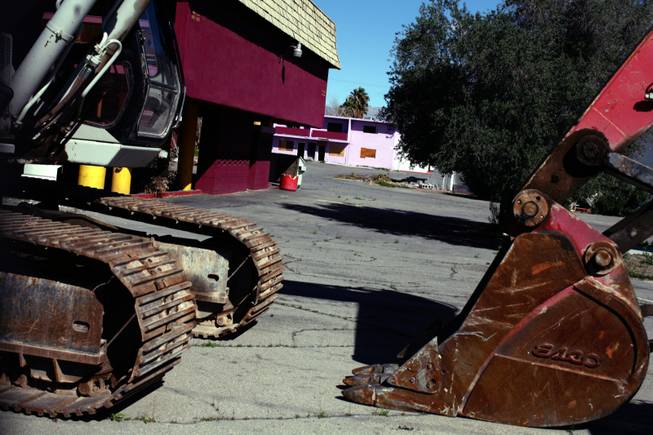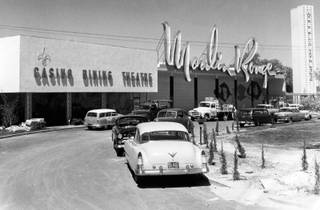
In light of progress at the site, the Las Vegas City Council recently dropped its claim that the Moulin Rouge, the iconic but long-vacant former casino on Bonanza Road east of Martin Luther King Boulevard, must be demolished.
Wednesday, March 11, 2009 | 2 a.m.
Sun Archives
- Once again, a plan for renewing the Moulin Rouge (2-25-2008)
- Low-income residents pushed closer to streets (9-14-2006)
- Historic casino faces challenges (5-27-2005)
- Moulin Rouge revival planned (1-29-2004)
- Blaze is latest chapter in hotel's storied history (5-29-2003)
Historical stories
- Moulin Rouge staff features 'big names' (5-25-1955)
- Nearly finished resort hotel damaged by fire (4-7-1955)
Despite its auspicious beginnings, the odds have been stacked against the Moulin Rouge, the historic former casino, for as long as many can remember.
After the first integrated casino in Las Vegas history closed in 1955, cheap, poorly maintained apartments took root. In 2003 a fire caused $12 million in damage. A few years later a man whose room had no heat died of hypothermia there.
Things, it would seem, have gone from bad to worse.
Development plans have been announced several times over the years.
Because of a consistent pattern of neglect, Las Vegas late last year began threatening to demolish the 15-acre property on Bonanza Road east of Martin Luther King Boulevard. And last month Moulin Rouge Properties, about $40 million in debt, filed for bankruptcy.
Despite all of this, as well as a firmly entrenched recession, a company spokesman says prospects for a fully redeveloped Moulin Rouge casino and hotel are on the upswing.
“This project has everything except the money,” Jayson Bernstein said.
Bernstein, with local public relations group Corporate Ignition, said the company has a gaming license, an architect and other planners on board — and is working toward a May groundbreaking and a 2011 opening. When all is said and done, the project could bring as many as 7,000 new jobs to the area, he said.
In February 2008, a Fairfax, Va.-based investment firm called Republic Urban Properties announced it would invest up to $1 billion for a spacious casino and 41-story hotel on the site. The company’s current role is unclear.
According to Bernstein, Republic has decided to lessen its role. Instead of raising the money to develop the site, Republic is now acting solely as a property lien holder, he said.
But David Peter, Republic’s President and chief executive, disputed that notion in an e-mail to the Sun.
“Republic is not serving just as a lien holder, nor has it abandoned its interest in being the developer of the Moulin Rouge,” Peter wrote. “We are continuing to work with (Moulin Rouge Development Corp.) and the lenders, in addition to seeking financing from other sources, and we hope to see through the bankruptcy process in order to stay involved as the ultimate developer of the project.”
Regardless of who the project’s developer will be, it will need financing during one of the worst economic times in Las Vegas history.
The project has other things working against it. It’s located in a blighted neighborhood. Then there is the property’s dilapidated status.
The City Council last week dropped its claims that the Moulin Rouge needed to be demolished immediately because the structure had become dangerous, not to mention overrun by feral cats and dogs and other pests.
The owners at first appealed the city’s demands. Then they said demolition could be avoided with some fixes they were willing to undertake.
According to Bernstein, the city dropped its demands because progress was being made. Workers are cleaning up the property.
Bernstein said the company also recognizes there are outstanding fines the company owes the city, and that the matter will be worked out between the parties.
City Councilman Ricki Barlow, whose Ward 5 includes the site, said he’s hopeful for a redeveloped Moulin Rouge, which “would be a great development to the community, culturally and economically.”
But Barlow said he recognized that the Moulin Rouge is currently an “underdog” to receive financing to move forward. “A lot of people are after the same pot of money,” he said.
Other observers questioned whether the redevelopment could — or should — proceed with the current developers.
“It’s historically significant, but it’s not sustainable in its current location, or with its current owners,” said Rainier Spencer, director of UNLV’s Afro American Studies program.
Spencer said that instead, a museum should be opened on a different site using exhibits from the hotel.
Bernstein responded by saying a museum was not being planned by the site’s owners, but that a “nod” to the casino’s historical significance would be made in the redeveloped property.
The iconic “Moulin Rouge” sign will be given to the Neon Museum, Bernstein said.
Open for a period of months in 1955, the Moulin Rouge was the first integrated casino in the region. In 1960 several prominent Las Vegas figures, including then-Las Vegas Sun Publisher Hank Greenspun, met on the site and agreed to end segregation on the Strip.


Join the Discussion:
Check this out for a full explanation of our conversion to the LiveFyre commenting system and instructions on how to sign up for an account.
Full comments policy